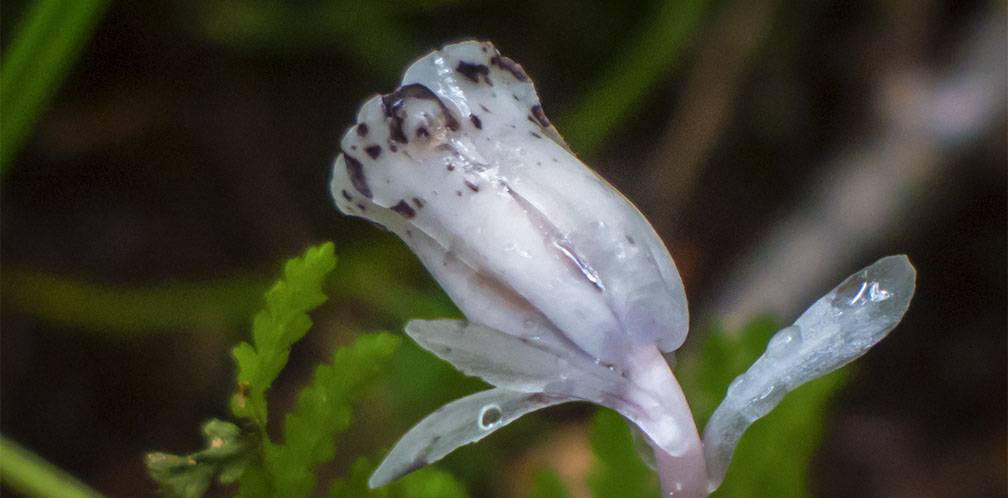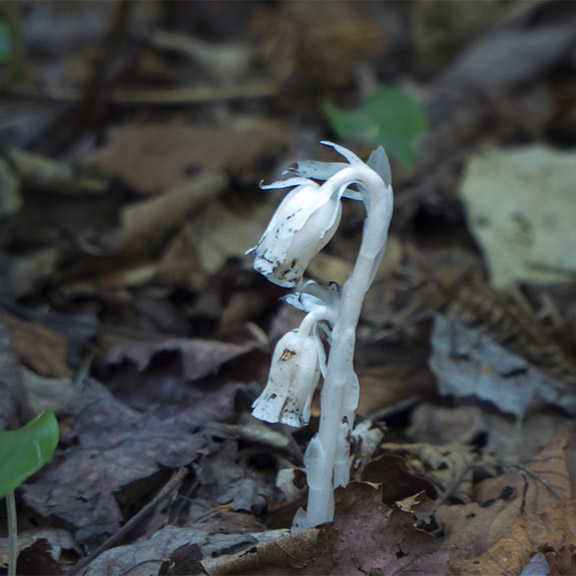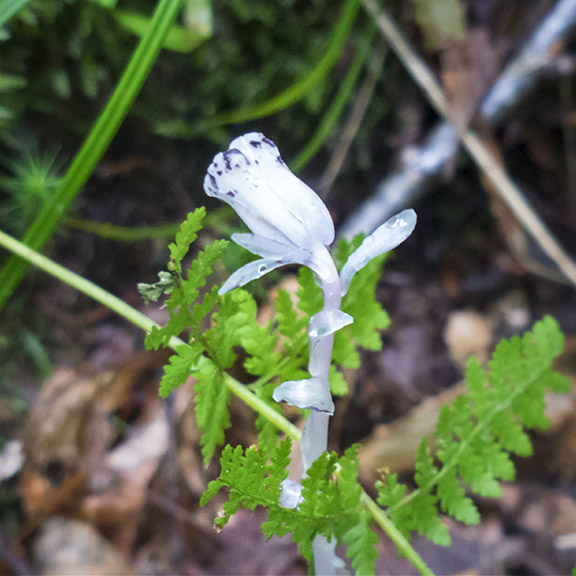Wildflowers of the Adirondacks:
Indian Pipe (Monotropa uniflora)

Indian Pipe is a native wildflower with a thick, white translucent stem ending in a white nodding flower. It grows in the Adirondack Mountains of upstate New York.
Indian Pipe derives its common name from its supposed resemblance, when in flower, to a peace pipe. Other common names include Indianpipe, Indian-pipe, One-flower Indian Pipe, Ghost Plant, Corpse Plant, Ghost Pipe, and Ghost Flower. The latter names are a reference to the plant's waxy, ghostly appearance. The plant has also been known as Ice Plant (because it is said to resemble frozen jelly and melts when handled) and Bird's Nest (a reference to the shape of its tangled root fibers).
The genus name (Monotropa) means "one turn" in Greek – a reference to the sharp curve of the top of the stem. The species name (uniflora) is Latin for "one-flowered" – a reference to the fact that each stem bears only one flower.

Indian Pipe is a parasitic plant that lacks chlorophyll, so it is unable to obtain energy from sunlight as most plants do. It is one of an estimated 3,000 species of non-photosynthetic flowering plants. At one time, it was believed that Indian Pipe absorbed nutrients from decayed organic material. This is not the case. We now know that Indian Pipe obtains its nutrients by tapping into the resources of trees, indirectly through myccorhizal fungi.
- The tree obtains its energy from photosynthesis.
- The fungi (in the genera Russula and Lactarius) obtains its nutrients directly from the tree roots.
- The Indian Pipe gets its nourishment through the fungi, which acts as a middleman that processes food delivery to Indian Pipe from its green neighbors. This relationship is called mycotropism.
Plants like Indian Pipe are known as epiparasites: parasites that feed on other parasites.
Identification of Indian Pipe

Indian Pipe is a low-growing plant, about four to ten inches tall. The whole plant is waxy white in appearance when young, although some specimans can have pale salmon pink coloration and black specks. The stem is thick and translucent. Stems can be found alone, but are commonly found in small clusters. Stems break easily when new.
Indian Pipe leaves are translucent scale-like appendages arrayed down the stem, less than an inch in length. The leaves are vestigial, since they do not carry on photosynthesis.
Indian Pipe bears a single, four- to six-parted white flower. The flowers are about 3/4 inches long and waxy white, like the stem. Plants have only one flower per stem.
The flower initially looks like a shepherd's hook, but slowly straightens after it is pollinated by an insect. At that point, the stem becomes upright. Indian Pipe usually begins blooming in the Adirondacks in late July and blooms into August, although it may appear in late June in some years.
Uses of Indian Pipe
Although Indian Pipe is said to be edible, one source suggests that it may be toxic. In any case, it should not be consumed, because it is too scarce to harvest. The plant was used by some native North American Indian tribes for medicinal purposes. Cherokee tribes, for instance, reportedly used the pulverized root as an anticonvulsive, while the Mohegans used an infusion of the root or leaves as an analgesic. The Cree chewed the flower as a remedy for toothache.
Wildlife Value of Indian Pipe
No wildlife uses of Indian Pipe were found.
Distribution of Indian Pipe
Indian Pipe is native throughout North America, except for parts of northern Canada, from Northwestern California to Alaska; east across the northern part of the western and most of the eastern United States. Indian Pipe is found in most counties in New York State and in all counties within the Adirondack Park Blue Line, except for Clinton, Fulton, and Saratoga counties.
Habitat of Indian Pipe
Indian Pipe grows in a wide variety of well-drained, shady sites. Indian Pipe apparently does not do well in recently disturbed areas. In the Forest Ecosystem Research and Demonstration Area (FERDA) at the Paul Smiths VIC, an inventory of plants taken a decade after logging operations showed a decline in frequency for Indian Pipe on three of the five blocks that had been logged: shelterwood, single tree cut, and clearcut.
In the Adirondack Mountains, Indian Pipe grows in both hardwood and mixed wood forests, up to an elevation of about 4,000 feet. This species may be seen on many of the trails discussed here. It can be found growing on a bed of moss under conifers or on a bed of deciduous leaves under hardwoods.
References
Michael Kudish. Adirondack Upland Flora: An Ecological Perspective (The Chauncy Press, 1992), pp. 16, 147.
New York Flora Association. New York Flora Atlas. Indian-pipe. Monotropa uniflora L. Retrieved 15 April 2017.
United States Department of Agriculture. The Plants Database. Indianpipe. Monotropa uniflora L. Retrieved 15 April 2017.
United States Department of Agriculture. Forest Service. Plant of the Week. Ghost Pipe (Monotropa uniflora L.) Retrieved 15 April 2017
Flora of North America. Monotropa uniflora Linnaeus. Retrieved 15 April 2017.
NatureServe Explorer. Online Encyclopedia of Life. Monotropa uniflora – Linnaeus. Retrieved 15 April 2017.
New England Wildflower Society. Go Botany. One-flowered Indian-pipe. Monotropa uniflora L. Retrieved 15 April 2017.
New York State. Department of Environmental Conservation. New York Natural Heritage Program. Ecological Communities of New York State. Second Edition (March 2014), p. 121. Retrieved 17 October 2015.
New York Natural Heritage Program. 2021. Online Conservation Guide for Hemlock-Northern Hardwood Forest. Retrieved 25 July 2021.
New York State. Adirondack Park Agency. Preliminary List of Species Native Within the Adirondack Park Listed Alphabetically by Scientific Name and Sorted by Habit. Volume 1. Updated 10.23.2006, p. 29. Retrieved 26 January 2017.
Connecticut Botanical Society. Indian Pipe. Monotropa uniflora L. Retrieved 15 April 2017.
University of Wisconsin. Flora of Wisconsin. Monotropa uniflora L. Retrieved 15 April 2017.
Minnesota Wildflowers. Monotropa uniflora (Indian Pipe). Retrieved 15 April 2017
Lady Bird Johnson Wildflower Center. Monotropa uniflora. Retrieved 15 April 2017.
Mark J. Twery, at al. Changes in Abundance of Vascular Plants under Varying Silvicultural Systems at the Forest Ecosystem Research and Demonstration Area, Paul Smiths, New York. USDA Forest Service. Research Note NRS-169. Retrieved 22 January 2017, p. 7.
John Eastman. The Book of Forest and Thicket: Trees, Shrubs, and Wildflowers of Eastern North America (Stackpole Books, 1992), pp. 114-115.
Plants for a Future. Monotropa uniflora - L. Retrieved 15 April 2017.
Steven Foster and James A. Duke. Medicinal Plants and Herbs of Eastern and Central North America (Houghton Mifflin Harcourt, 2014), pp. 38-39.
University of Michigan. Native American Ethnobotany. A Database of Foods, Drugs, Dyes and Fibers of Native American Peoples, Derived from Plants. Indianpipe. Monotropa uniflora L. Retrieved 15 April 2017.
Anne McGrath. Wildflowers of the Adirondacks (EarthWords, 2000), pp. 20.
Doug Ladd. North Woods Wildflowers (Falcon Publishing, 2001), p. 198.
Lawrence Newcomb. Newcomb's Wildflower Guide (Little Brown and Company, 1977), pp. 172-173.
Roger Tory Peterson and Margaret McKenny. A Field Guide to Wildflowers. Northeastern and North-central North America (Houghton Mifflin Company, 1968) pp. 232-233.
National Audubon Society. Field Guide to Wildflowers. Eastern Region. (Alfred A. Knopf, 2001), pp. 637-638.
William K. Chapman, et al. Wildflowers of New York in Color (Syracuse University Press, 1998), pp. 32-33.
Nancy G. Slack and Allison W. Bell. Adirondack Alpine Summits: An Ecological Field Guide (Adirondack Mountain Club, Inc., 2006), p. 27.
Thomas J. Volk, University of Wisconsin-La Crosse. Fungus of the Month. Monotropa uniflora. Retrieved 15 April 2017.
Charles H. Peck. Plants of North Elba (Bulletin of the New York State Museum, Volume 6, Number 28, June 1899), p. 114. Retrieved 22 February 2017.
